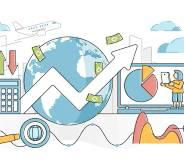Microeconomics
- Alexandru Moleavin

- Apr 22, 2024
- 2 min read

Microeconomics is a branch of economics that studies the behaviour of individuals and firms in making decisions regarding the allocation of limited resources and the interactions between these individuals and firms. It focuses on the analysis of specific economic factors, such as households, consumers, workers, and businesses, as well as the determination of prices and quantities of goods and services. Simply put, microeconomics is a branch of economics that studies how an overall economy works.
To better understand the concept, let’s jump into some key topics related to it:
• Supply and demand: As the price increases 📈 , supply (number of goods produced) rises 📈 and demand (number of people willing to buy) declines. Conversely, as the price drops 📉, supply constricts and demand grows.
• Market equilibrium: In an equilibrium state, market supply and demand reach a balance, leading to price stability. Typically, an excess supply of goods or services leads to price decreases, which leads to higher demand. A shortage or insufficient supply leads to price increases, resulting in reduced demand.
• Price elasticity: Price elasticity of demand is a measurement of the change in the number of people which buy a product in relation to a change in its price. It is calculated using a formula: percentage change in the number of buyers / percentage change in the price.
• Monopolistic competition: There are a lot of producers competing in the same industry against each other. Examples include : fast food restaurants( KFC, McDonald’s and Subway), automotives ( Honda, Hyundai, GMC) and many others. Their products are similar, but not the same.
• Oligopolistic competition: A small number of producers compete to sell similar, but not the same products. To better understand the concept, think about how many competitors Microsoft has for its licenses (not many), compared to Coca-Cola’s competition ( hundreds of other brands).
• International trade: International trade involves the transfer of capital, commodities, and services between countries or regions, driven by the demand or desire for specific goods or services. This exchange occurs across international boundaries or territories. International trade is relevant to microeconomics because it expands the set of available resources and markets for goods and services, influencing how resources are allocated within an economy.
• Game theory: Mathematical models are used to simulate the behaviour of companies. Think of it as a bigger game of chess, as it takes into account the actions of one individual over himself and others.
In conclusion, microeconomics studies the decisions of individuals and firms to allocate resources of production, exchange, and consumption. It deals with prices and production in single markets and the interaction between different markets but leaves the study of economy-wide aggregates to macroeconomics.This branch of economists formulates various types of models based on logic and observed human behavior and test the models against real-world observations.
Bibliography:




Комментарии